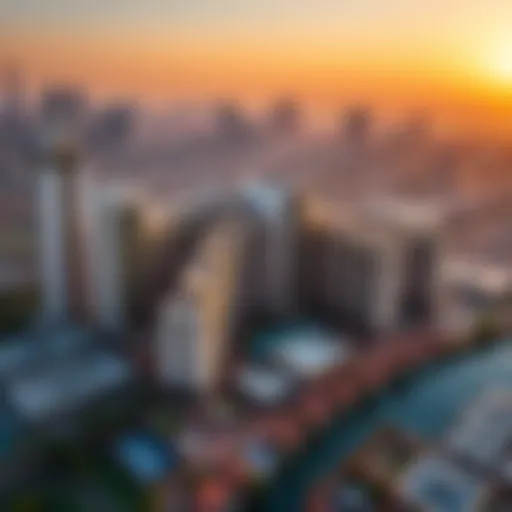Exploring the Liwan Gate: A Marvel of Dubai's Architecture
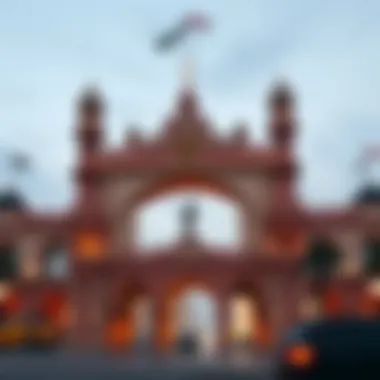
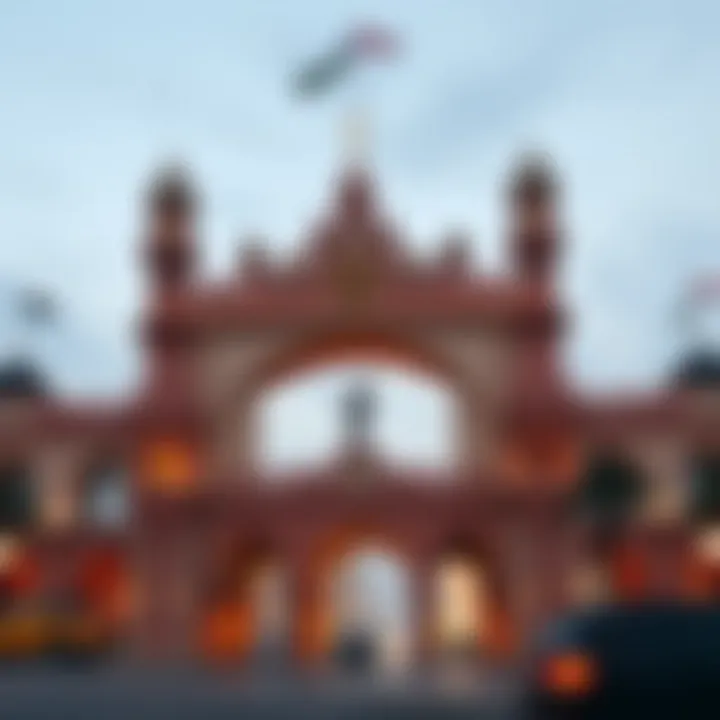
Intro
In the heart of Dubai lies a remarkable architectural feature known as the Liwan Gate. This impressive structure does more than just mark a boundary; it serves as a symbol of the city’s complex layering of history and modernity. Built against the backdrop of Dubai's rapid evolution, the gate stands as a testament to the dynamic interplay between tradition and contemporary design.
As we journey through this exploration, we will uncover the historical context of Liwan Gate, examining how it came to be and what makes it a significant landmark among Dubai's other architectural wonders. We will also dissect the design elements that contribute to its visual showcase and cultural resonance.
The impact of Liwan Gate extends beyond its physical presence; it nurtures not only the aesthetic landscape but also the social dynamics of its neighborhood. This article seeks to provide readers with a comprehensive understanding of Liwan Gate, focusing on its place within the broader narrative of Dubai's growth, its importance to the local community, and its allure to visitors from across the globe.
Through this detailed narrative, we aim to impress homeowners, visitors, urban planners, and architects alike, ensuring every one of you can appreciate the architectural marvel that is Liwan Gate.
Preface to Liwan Gate
The Liwan Gate stands out as a notable landmark in Dubai, attracting not just admirers of architecture but also those keen to understand the intricate layers that define a city's identity. This architectural structure is more than just stone and mortar; it encapsulates the spirit of a community and exemplifies the rapid transformation of urban landscapes. As we navigate through the story of Liwan Gate, it is important to understand its historical significance and geographical implications, framing it in a broader context of Dubai's growing civic presence.
Diving deeper into the nuances of the Liwan Gate sheds light on its role within the city, spotlighting various aspects, from its aesthetic appeal to its structural importance. Homeowners, visitors, and urban planners alike can glean valuable insights from the tale of this structure—after all, a city's architecture often reflects the dreams, aspirations, and cultural legacies of its people. Engaging with such a landmark fosters a connection not only with the place itself but also with the stories it holds.
Historical Overview
The genesis of Liwan Gate can be traced back to a specific period in Dubai’s history marked by significant development. As the city transitioned from a modest trading port to a bustling cosmopolitan hub, Liwan Gate emerged as a symbol of this metamorphosis. While the structure itself showcases contemporary design advancements, it pays homage to the architectural traditions of the region. Each curve and contour tells a story, echoing past influences and narratives.
The design of Liwan Gate reflects the innovations made during the UAE's rapid growth in the 21st century, while also acknowledging the heritage of the area. Unlike many of its counterparts, this gate engages with its history rather than merely serving as a modern façade, providing context for how residents and visitors perceive both time and space in this vibrant city.
Location and Geographical Significance
Nestled within a strategically chosen area of Dubai, the Liwan Gate is more than just a decorative feature. Its placement has implications that stretch as far as transit routes to social dynamics. Positioned near major thoroughfares, the gate acts as a nexus connecting different parts of the city, enhancing flow and movement for pedestrians and vehicles alike. The surrounding landscape too has been shaped by its presence, transforming the area into a vibrant public space.
The gate’s geographical significance can also be tied to its proximity to cultural and commercial hubs. It stands as a gateway, both literal and metaphorical, to the heart of Dubai. Its location makes it an ideal spot for residents and tourists to gather, fostering both community interaction and cultural exchange in a bustling metropolis. With its carefully considered positioning, Liwan Gate is far more than an architectural curiosity; it embodies the essence of Dubai's urban planning philosophy.
Architectural Features of Liwan Gate
The architectural features of Liwan Gate serve as a testament to the blend of tradition and modernity that is so prevalent in Dubai. This gate isn’t just a structure; it's a narrative, showcasing the importance of aesthetic and functional elements that define an architectural marvel. Delving deeper into design influences, materials utilized, and the symbolism in design, this section illuminates how each facet contributes to the overall significance of the gate.
Design Influences
The design of Liwan Gate draws from a distinctive array of cultural influences. One can see how Middle Eastern motifs intertwine with contemporary architectural styles. The sweeping arcs and intricate details on the facade echo traditional Islamic art, while the overall concept resonates with modern minimalism. This combination speaks volumes about Dubai's quest to honor its heritage while embracing a forward-thinking mindset.
By incorporating elements like mashrabiya screens, the design invites airflow and provides shade, marrying beauty with functionality. Additionally, the curved lines mimic the surrounding dune landscapes, creating a seamless transition between man-made control and natural geography.
"The Liwan Gate not only serves as an entryway but as a conversation starter, reflecting a socio-cultural dialogue across various eras."
Materials Used
Liwan Gate is constructed using a mix of traditional and modern materials that highlight craftsmanship while ensuring longevity. The primary materials include local stone, concrete, and glass, each serving a specified purpose that reiterates both beauty and utility. The stone lends a sense of authenticity and regional rootedness, while the glass allows light to play throughout the structure, enhancing its allure.
In the gate's arches, one might observe the use of terracotta tiles, another nod to the region’s artisan heritage. These tiles are not merely decorative; they're designed to withstand the harsh climatic conditions of the UAE. Choosing locally sourced materials minimizes the environmental footprint, aligning with sustainable practices in architecture.
Symbolism in Design
Symbolically, Liwan Gate acts as a portal, representing the entry into a space that balances the throbbing pulse of urban life with serene communal areas. The elements of its design—like the ornate motifs—speak to the rich cultural narrative of Dubai, indicating a blending of past and future.
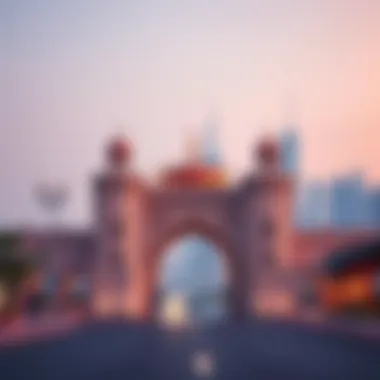
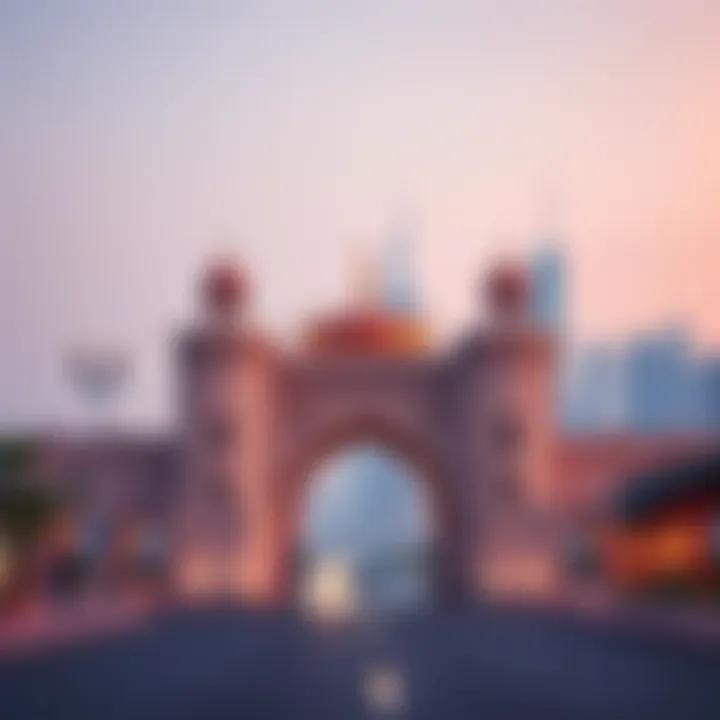
The gate also symbolizes unity, connecting various facets of the community. Whether viewed as a welcoming structure for tourists or an emblem of local pride for residents, it’s a powerful reminder of the diverse cultures converging in this vibrant city.
Through these features, Liwan Gate emerges not just as an architectural landmark but as an embodiment of the spirit and aspirations of Dubai's populace.
Cultural Significance
The Liwan Gate holds more than just aesthetic appeal in the bustling city of Dubai. Its cultural significance is deeply woven into the fabric of the community it serves, fostering identity and connection among residents and visitors alike. This section explores how the Liwan Gate embodies the essence of local culture and acts as a bridge linking the past to today’s dynamic urban life.
Role in Community Identity
Liwan Gate stands as a symbol of pride for the nearby communities. It represents not merely a physical structure but a testament to the rapid growth Dubai has experienced. Many folks see it as a marker of their journey, a gateway to opportunities and development.
- Shared Gathering Space: The area around Liwan Gate often serves as a venue for local events, celebrations, and community activities. This transforms the gate into a gathering place where individuals forge bonds and build relationships, fostering a sense of belonging.
- Civic Engagement: The Liwan Gate encourages civic pride, which in turn inspires active participation in local affairs. By hosting various cultural events, it elevates community engagement, offering a platform for voices to be heard and stories shared.
- Cultural Memory: It's not just any gate; it's a reminder of Dubai's rich heritage. The stories told of the gate resonate through generations, giving the community a shared historical context that enriches their identity.
Connection to Local Traditions
The architecture and design elements of the Liwan Gate reflect traditional Emirati values and aesthetics, linking the present with the historical nuances of the region. The incorporation of local motifs and styles signifies more than just an architectural choice; it is a celebration of cultural heritage.
- Artistic Expression: The visual elements of the Liwan Gate draw upon traditional art forms unique to the Emirates. By integrating these designs, it honors the past and keeps the local art alive in the consciousness of new generations.
- Educational Nexus: The gate can also serve as a portal for learning about local history and traditions. Schools and community groups often organize tours or events here, igniting curiosity in younger audiences about their heritage and cultural practices.
In summary, the Liwan Gate is not merely an architectural feature; it’s a vital part of Dubai’s cultural landscape. Its role in reinforcing community identity and connecting with local traditions cannot be overstated. Well beyond its physical structure, it embodies the essence of community spirit and acts as a beacon of cultural continuity.
Liwan Gate in Urban Planning
The Liwan Gate stands not just as a visual marvel but also plays a crucial role in the urban planning of Dubai. In this bustling metropolis, where every corner seems to tell a story of rapid growth and modernity, the gate acts as a bridge between the past and the future. Its strategic positioning and architectural elegance contribute significantly to the character and functioning of the surrounding areas.
Impact on Neighboring Areas
The presence of the Liwan Gate has had profound effects on neighboring districts. First and foremost, it acts as a catalyst for economic activity. By attracting visitors and residents alike, surrounding businesses have flourished. Tiny cafes, art galleries, and shops previously unnoticed now thrive in the newfound foot traffic.
- Increased Property Values: With the influx of visitors, property values in the vicinity have seen a notable rise. Homeowners who might have found themselves in stagnant markets are now witnessing a rebound in real estate interest.
- Enhanced Community Facilities: The gate’s significance has also prompted local planners to invest in community facilities such as parks and recreational spaces. This enhancement of local infrastructure not only benefits residents but also creates amiable gathering spots for tourists.
- Urban Cohesion: By linking various segments of the city, the Liwan Gate helps to promote urban cohesion. Its design encourages people to explore the neighborhoods around it, making parts of Dubai that might have felt isolated feel more connected.
"The Liwan Gate is more than an entrance; it’s a key that unlocks the potential of surrounding communities."
Integration with Urban Landscape
The architectural brilliance of Liwan Gate does not stand in isolation; instead, it melds into the urban fabric of Dubai with finesse. Its integration into the urban landscape provides a balanced view of modern design while celebrating the rich cultural heritage of the region.
- Harmonious Design: The design of the gate complements other structures in the area, showcasing both contemporary and traditional elements that resonate with local architecture.
- Green Spaces: The planning around the Liwan Gate incorporates green spaces that improve biodiversity. Parks and green patches not only beautify the area but also help in maintaining ecological balance within an urban environment.
- Mobility Considerations: The site is designed with accessibility in mind. With various transport options available near the gate, visitors can navigate the urban landscape with ease. Public transport links and sidewalks leading to the gate encourage a pedestrian-friendly atmosphere, promoting walking and reducing vehicular traffic.
Integrating the Liwan Gate into the urban planning strategy of Dubai enhances not only its architectural appeal but also strengthens community ties, promotes sustainability, and elevates the city’s overall quality of life. As Dubai continues to evolve, the significance of such landmarks will only grow, serving as vital nodes in the city’s ongoing narrative.
Visitor Experience
The experience of visiting the Liwan Gate goes beyond just admiring its architectural grandeur; it encompasses the entire journey and the emotions that accompany it. It’s important to note that for many, the gate represents not just a physical structure, but a gateway to a narrative infused with history and culture.
Accessibility and Transportation
Accessing the Liwan Gate is straightforward, making it an inviting landmark for both locals and visitors. Situated near key transit routes, the gate is conveniently reachable via various modes of transportation. Public buses frequent the area, and nearby metro stations, like the one at Dubai Mall, serve as vital points for travelers.
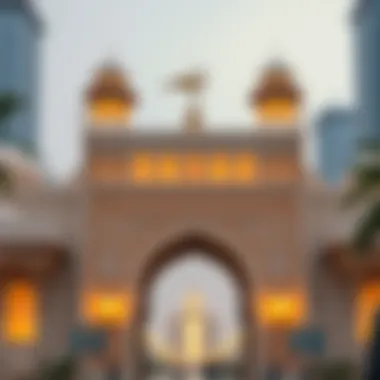
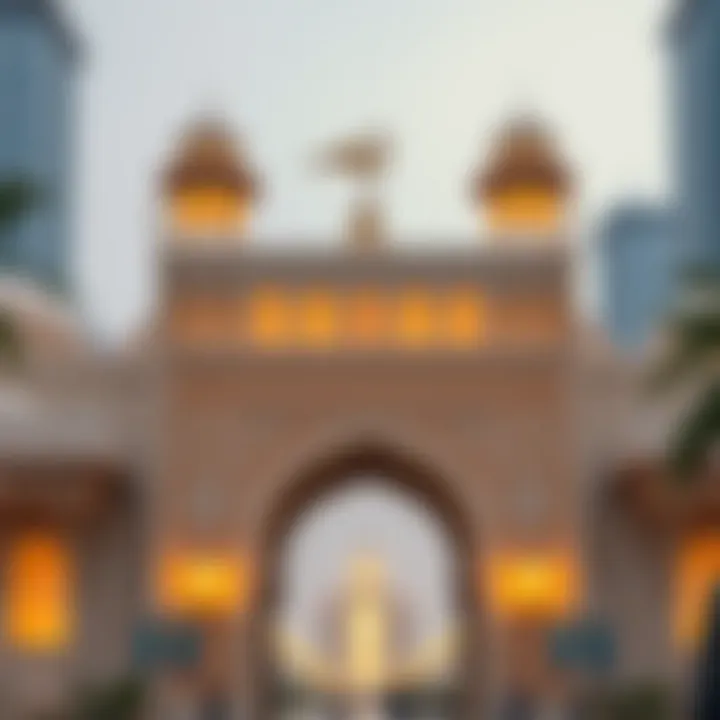
Moreover, the presence of ample parking spaces allows those driving to easily park and explore at their leisure. The layout of roads leading to the gate is designed for smooth traffic flow, minimizing delays for visitors. As culture is often best appreciated firsthand, having accessible transport options ensures that more people can engage with this architectural jewel.
However, it’s worth considering peak hours when planning a visit, as these times can lead to congestion both on the roads and around the gate itself. You might want to steer clear of visiting during the bustling lunch hour or right after work when local traffic picks up. Thus, choosing a time during the middle of the day could provide a more relaxed experience.
Surrounding Attractions
Beyond the impressive structure of the Liwan Gate lies a plethora of attractions that enhance the visit. Just walking distance from the gate are several cultural and recreational spots that complement the experience. Here’s a quick breakdown:
- Dubai Frame: A stunning architectural marvel that offers panoramic views of both modern and old Dubai, allowing a unique perspective of the city’s growth.
- Al Fahidi Historic District: A stroll through this quaint area gives visitors a taste of the city’s past, displaying traditional wind-tower architecture.
- Dubai Creek: A short ride will take you to the banks of this historic waterway, where you can experience local markets and traditional dhows.
From art galleries showcasing local talents to cafes that serve authentic Emirati cuisine, each of these attractions provides a rich tapestry of experiences that resonate with the local culture. Embracing these surrounding sites not only enhances the trip but contributes to a deeper understanding of the Liwan Gate’s role in the larger context of Dubai’s narrative.
"The Liwan Gate is not just a structure; it's a reflection of Dubai’s aspirations and a gateway to its storied past."
When you plan a visit to the Liwan Gate, consider staying a while in the vicinity to absorb what the area has to offer fully. This blend of accessibility and adjacent attractions makes it an appealing spot for an immersive exploration. Visitors often find themselves captivated not only by the gate but by the profound cultural stories surrounding it.
Environmental Considerations
When discussing the Liwan Gate, one cannot overlook its environmental considerations. These aspects are crucial not just for the architectural integrity of the structure, but for the broader ecological footprint it casts over Dubai. As urban areas expand, the architecture must evolve with sustainability at its core, thus ensuring a balance between development and nature. The Liwan Gate stands as an example of merging aesthetic appeal with environmental responsibility, serving as a beacon of hope for future urban projects.
Sustainability in Design
Sustainability is no longer just a buzzword; it's a pressing requirement in modern architecture. The Liwan Gate embodies this necessity through various sustainable design elements. Using eco-friendly materials minimizes carbon emissions, while energy-efficient systems help reduce resource consumption. The incorporation of solar panels into the design allows the structure to harness sunlight, providing a renewable energy source.
Moreover, the orientation of Liwan Gate has been carefully planned to maximize natural lighting. This does not only cut down on electricity use but also creates a healthier environment for occupants and visitors alike. Architecturally speaking, the use of local materials reduces transportation emissions and connects the structure to its geographical context, promoting a sense of place amidst urban uniformity.
Aspects to consider when evaluating sustainability include:
- Energy-efficient lighting systems
- Water-saving fixtures and rainwater harvesting
- Sustainable landscaping practices
- Use and sourcing of local materials
Adopting these practices sets a powerful precedent for future architectural endeavors, encouraging others in Dubai to follow suit.
Biodiversity and Green Spaces
Integrating biodiversity and green spaces into urban design promotes not just environmental health but also community well-being. The Liwan Gate is flanked by well-maintained green spaces that provide habitats for local wildlife, adding vibrancy to the environment. This touches on the increasing recognition of urban biodiversity and its crucial role in maintaining ecological balance.
The surrounding greenery not only supports local fauna but also offers a serene escape for residents and visitors. A well-planned landscape provides shade, reduces urban heat, and enhances air quality. It’s essential for people to have easy access to these green areas, as they contribute significantly to the social and psychological aspects of urban living.
Key benefits of green spaces include:
- Improvement in air quality through natural filtration
- Reduction of urban heat island effect
- Promotion of mental health and community interaction
- Support for local flora and fauna
In essence, the environmental considerations surrounding the Liwan Gate highlight the importance of sustainable design and the cultivation of biodiversity. As urban landscapes become more complex, the need to address these topics is paramount, ensuring that future architectural projects contribute positively to both the community and the ecosystem.
Future of Liwan Gate
As Dubai continues to steadily evolve, the future of Liwan Gate is not only reliant on its physical structure but also is symmetrically intertwined with the values and aspirations of the community it symbolizes. The relevance of this future cannot be overstated; this architectural gem serves as a crossroads for innovation, culture, and local identity. With planned enhancements and community initiatives, Liwan Gate is poised to cement its status as more than just a landmark, but rather a beacon for residents and visitors alike.
Planned Developments
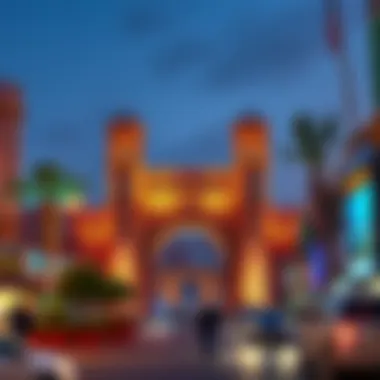
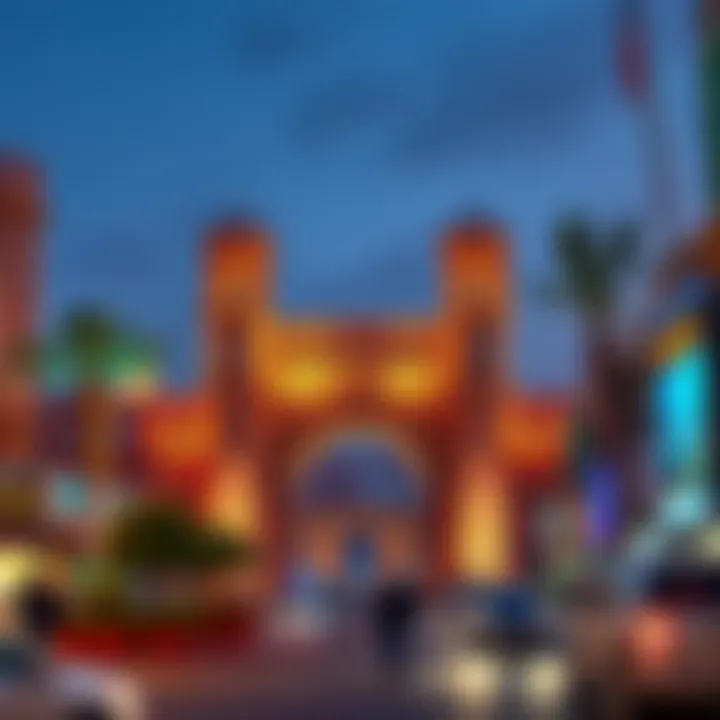
Looking ahead, several ambitious developments are on the cards for Liwan Gate. There’s chatter about expanding the surrounding public spaces, aiming to create a more inviting environment for diverse activities. The enhancements are expected to include:
- Public Art Installations: Integrating local artistry to celebrate Emirati culture.
- Event Spaces: Areas designed for community gatherings, market days, and cultural festivals.
- Transportation Improvements: Enhanced accessibility through better public transit links, ensuring that visitors can easily reach this architectural wonder.
This focus on developments has not just functional aspects, but also promotes interaction, helping to fortify the bonds within the community and with its visitors. Each new element being planned serves as a stitch in the vibrant tapestry that makes Liwan Gate a pillar of Dubai’s architectural narrative.
Knotting Community Engagement
Engagement with the community is essential in shaping the future of Liwan Gate. As plans unfold, it’s crucial to weave the voices of the residents into the fabric of development. One method being explored is organizing forums and roundtable discussions where locals can share their ideas and concerns about future upgrades. This allows their perspectives to influence design choices, ensuring that the gate reflects their collective identity.
Furthermore, forming partnerships with local schools and organizations to create educational programs centered around architecture and cultural history could deepen residents’ connection with the gate. Projects like mural days, cleanup initiatives, or even volunteer-led workshops can enhance stewardship for the space and instill pride among community members.
"To truly own a place, you must feel its heartbeat and let your contributions shape its story."
Through these initiatives, Liwan Gate has the potential to not only stand as a grand architectural feature but evolve into a living, breathing entity representative of Dubai's multicultural embrace. The journey ahead is littered with opportunities to enrich this landmark and the lives of those who dwell around it.
Comparative Analysis
Understanding the Liwan Gate within the context of comparative analysis allows for a broader appreciation of its significance. This architectural marvel, situated in the heart of Dubai, embodies not only aesthetic appeal but also cultural and urban narratives that resonate with both past and present. By evaluating it alongside similar landmarks, we can glean insights into its role and impact on Dubai’s evolving landscape.
Similar Landmarks in Dubai
Dubai is replete with iconic structures that underscore its rapid growth and ambitious vision. Below are a few noteworthy landmarks:
- Burj Khalifa: The tallest building in the world is a pinnacle of modern engineering, contrasting with the traditional architecture represented by the Liwan Gate. Both structures serve as symbols of Dubai’s progression, yet they speak to different aspects of its identity.
- Dubai Frame: This architectural feat connects the old and new Dubai, much like how the Liwan Gate does. With its unique design, it offers a perspective that reflects on both historical and contemporary narratives.
- Sheikh Zayed Road: While not a building per se, this major highway showcases the city’s urban sprawl and modernization efforts. The road leads to various attractions, including the Liwan Gate, illustrating the interconnectedness of development and cultural heritage.
Benefits of Comparing Landmarks
Engaging in a comparative analysis allows us to:
- Analyze architectural trends: Each landmark offers a glimpse into prevailing design philosophies, revealing shifts in aesthetics based on time and function.
- Understand cultural significance: By exploring different structures, we can appreciate how they contribute to community identity and values.
- Evaluate urban planning: Distinguishing similarities and differences in layout and function can inform future urban development.
Contrasting Approaches to Urban Symbols
When we look at the Liwan Gate next to similar structures in Dubai, it's clear that each employs a unique lens for conveying civic pride and identity. While some structures favor stark, contemporary designs, the Liwan Gate leans into a narrative that resonates with local culture and tradition.
- Modernism vs. Tradition: Structures like the Burj Khalifa prioritize innovation, using cutting-edge materials and sleek lines. In contrast, the Liwan Gate aims to connect with the past, often utilizing traditional motifs that evoke heritage.
- Functionality vs. Symbolism: In many modern structures, the primary focus is often on functionality—think of residential towers that maximize space but may lack soul. The Liwan Gate, however, serves a dual purpose; it’s not just a physical entrance but a symbolic gateway that welcomes visitors into the essence of Dubai.
In summary, contrasting these approaches highlights the importance of understanding how architecture serves not just as a functional necessity but as a vessel for cultural expression. Further exploration into these comparisons can deepen our understanding of what structures like the Liwan Gate mean within the grander tapestry of Dubai’s urban development.
Ending
The examination of Liwan Gate wraps up an intricate tapestry of architectural significance and cultural resonance that extends beyond mere aesthetics. In the bustling landscape of Dubai, the gateway serves as a vibrant emblem, encapsulating the fusion of tradition and modernity. It stands not just as a physical barrier or threshold, but as a symbol of connection, bridging the past with the future.
Recap of Key Insights
In revisiting the key insights, it’s evident that:
- Historical Context: The Liwan Gate is deeply rooted in Dubai's heritage, reflecting the region's evolution from a modest fishing village to a global metropolis.
- Architectural Features: Notable for its striking design influence and materials, it represents an aesthetic that harmonizes with Dubai's architectural landscape while standing distinct.
- Cultural Significance: The gate fosters community identity, serving as a meeting point for gatherings and celebrations, and breaching the gap between residents and visitors.
- Urban Planning Impact: Its integration within the urban fabric not only enhances the neighborhood but also contributes to environmental considerations that promote sustainability.
The Liwan Gate embodies not just a physical structure but a repository of stories, experiences, and aspirations.
The Lasting Legacy of Liwan Gate
As discussions gravitate towards the lasting legacy of the Liwan Gate, we recognize it not merely as a landmark but an ongoing narrative in the heart of Dubai. It reflects the city's spirit and ambition, inspiring architectural endeavors and urban developments for generations to come. Its accessibility and connection to local traditions enhance its role as a cultural landmark, inviting exploration and engagement.
This is a place where people gather, reflecting the vibrancy of community life in Dubai. The structure encourages interaction, stimulates tourism, and promotes cultural exchange, laying down a foundation for future endeavors. Moreover, the gate serves as a reminder of the delicate balance between progress and preservation, prompting both locals and visitors to contemplate the paths that connect history with the modern era.



